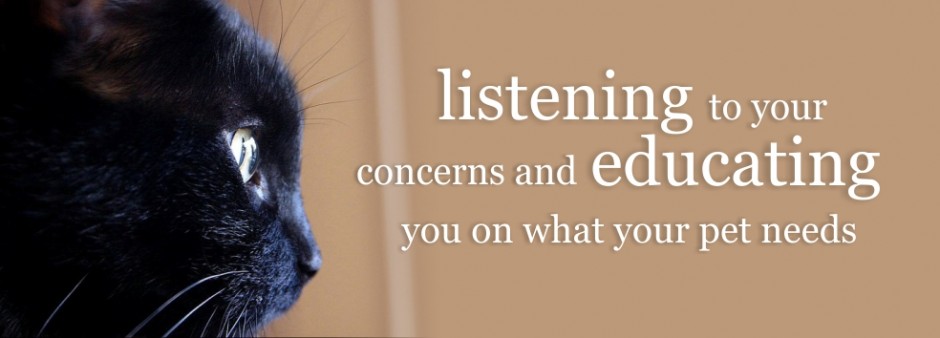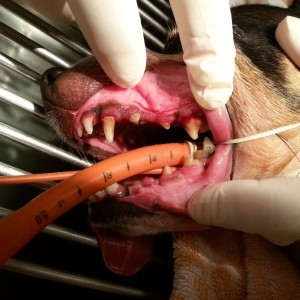How Important is Oral Health?
October 9, 2014
Have you ever had that moment of immediate humility? In the midst of your chaotic morning routine, you have forgotten to brush your teeth! In a sheer panic, you rifle through your glove box, center console or pocketbook for any lingering piece of dignity – or gum. You wonder for yourself if anyone will even notice? Well, let me tell you the good news. Your pet does not care if you brushed your teeth today. We sometimes find ourselves caught up in a whirlwind of ‘things to do today’, but what about the things we forgot to do today? For example, brushing your pet’s teeth. Don’t fret. You are not alone. According to the VetStreet blog, you may be among the 95% of pet owners who do not regularly brush their animal’s teeth. I am sure you will think of it the next time your pooch comes to give you a smooch.
Here’s my story.
As a working mother of 2 children, 2 dogs and 2 cats and also a part time student, I am here to admit to you that I fall into that ninety-fifth percentile. Here is what I can also tell you. At the bright age of 6, my little Chihuahua, Chester, was in dire need of a dental cleaning. Were his teeth diseased or lose? No. Was there any inclination of severe periodontal disease? No. He simply needed a cleaning. Why? That is a great question.
can also tell you. At the bright age of 6, my little Chihuahua, Chester, was in dire need of a dental cleaning. Were his teeth diseased or lose? No. Was there any inclination of severe periodontal disease? No. He simply needed a cleaning. Why? That is a great question.
A dental cleaning is something that, in my opinion, should be considered every few years for any pet. It is an excellent opportunity to simply prevent oral disease from happening. Isn’t that why we, as humans, go to the dental hygienist 1-2 times in per year? If you can look into your pet’s mouth and begin to see tartar building up, it may be time to consider a dental prophylaxis. Our pets can be very stoic creatures. They have been known to essentially wait until they can no longer physically eat anymore before complaining about oral pain. Furthermore, dental tartar can build up into calculous on the teeth causing inflammation of the gingival tissue (gingivitis). When gingivitis is present, the gum tissue may start receding and releasing harmful bacteria into the bloodstream. Once this bacteria enters the circulatory system, it may cause irreversible damage to vital organs. This could potentially do permanent harm to your pet. You may not always be able tell by what’s on the inside of your pet’s mouth, as only pre-anesthetic bloodwork will show such changes. My suggestion would be, start breaking down tartar before it builds into a problem!
How you ask?
At Chase Farm Veterinary Hospital, we carry products to help you do just that!
- Hill’s T/D
T/D prescription dry food’s large kibbles are designed to simulate your pet to chew. This chewing action helps to remove plaque and tartar. T/D can be used as daily treats or given as your pet’s regular diet. - Greenie
Much like T/D, this treat is designed to stimulate your pet to chew. The chewing action helps to remove tarter. - C.E.T. Chews
These treats have an antiseptic and abrasive texture that works with your dog’s chewing action to reduce plaque and loosen tartar. - C.E.T. Toothbrush and Toothpaste
Along with the motion of brushing, this enzymatic toothpaste helps to break down the plaque and tarter on your pet’s teeth. The toothpaste comes in vanilla-mint and poultry flavor.
How To Brush Your Pet’s Teeth – A Three Week Training Program
There are a few important things to remember in order to successfully introduce a brushing routine to your pet.
- Do it everyday.
- Do it at the same time everyday.
- Do it in the same place every day.
- Make it fun.
- Build up to a complete brushing gradually; don’t spend more than 30-60 seconds
initially.
Week 1
Pet the muzzle and pull back the lips to feel the gums with your fingers.
You can let your pet keep their mouth closed and still slip your finger into their
mouth. Remember to do this everyday at the same time and in the same place. Finish
with a special treat and lots of praise. If a special treat is given only at this time,
many pets will learn to look forward to these sessions.
Week 2
Pet the muzzle with the toothbrush and let your pet taste the toothpaste.
This week is the same procedure as week 1 but with the tooth brush and
toothpaste added. You should not try to brush the teeth this week; it should still
be a gradual “getting used to it” phase.
For cats, you can “pet” the muzzle and allow your cat to rub up against the brush.
Most dogs will like this step too since they will be able to taste the toothpaste.
Week 3
Brush the teeth.
Brush the top teeth first. Begin on either the left or right side. Start by moving the brush back and forth or with a circular motion along where the teeth and gums meet. Move the brush to the bottom teeth on the same side, and again, concentrate where the teeth and gums meet.
It’s ok if your pet chews the toothbrush; in fact, that allows him/her to brush their own teeth. It’s also ok if your pet licks the toothpaste.
** Human toothpastes should never be used. They can cause an upset stomach
if swallowed.
Repeat this process on the opposite side.
Lastly, brush the incisors
Start on the top and finish with the bottom. (These are
the small teeth in the front of your pet’s mouth.)
Remember that your pet may keep their mouth shut during the brushing. It is only
necessary to brush the outsides of the teeth.
Remember that you want to make brushing your pet’s teeth a positive and rewarding experience. Every pet is different; some may take several weeks to become comfortable with step one. Others may only require a few days to become comfortable.
If your pet’s veterinarian does recommend a dental cleaning, don’t fret!
Although animals do require anesthesia during the procedure, the Chase Farm Veterinary Hospital team will to everything possible to make sure the process is as easy as possible for both you and your pet.
What can you expect on the day of the procedure?
- Pre-Anesthetic Bloodwork
We require that all patients undergoing an anesthetic procedure have Pre-Anesthetic Blood-work run. The blood-work helps the doctor to ensure that your pet is a good candidate for anesthesia. Your veterinarian may draw the blood during an office visit if you are arranging to have a procedure done within the next few days, or you may come for a technician appointment on the day prior to surgery to have it drawn. Blood can also be drawn on the morning of surgery for those clients that are not able to come in before hand. Pre-Anesthetic Blood-work is considered valid for three months. - NPO (no food after midnight on the night prior to surgery)
Patients that will be undergoing an anesthetic procedure need to have food withheld after midnight on the night prior to surgery. Nausea can occur in anesthetized patients and a stomach filled with food can result in vomiting. If an animal vomits food while under anesthesia, the risk of aspiration is a concern. By eliminating all food, we greatly minimize this risk. - Drop off time
Surgery patients are admitted from 7:30 – 8:30 a.m. on the day of their scheduled procedure. You will meet the surgery technician at this time and be able to ask any last minute questions you might have. - What will happen while my pet is in the hospital?
If your pet has not yet had pre-anesthetic blood work run, the technicians will draw the blood and run it before the doctor arrives. When the doctor arrives, your pet will receive a physical exam and be given a premed injection. This injection will allow him/her to relax and rest comfortably until it is time for surgery.
While the doctor is performing the procedure, the surgery technician will stay by your pet’s side. She will be monitoring his/her heart rate, respiration rate, temperature, and blood pressure.
When the procedure is complete, your pet will wake up in the treatment room. He/she will be wrapped in warm blankets and the technicians and doctor will be keep an eye out to make sure he/she remains comfortable. - How will I know when my pet’s surgery is finished?
When your pet’s procedure is complete, the surgery technician will call to let you know. - What time will I be able to pick up my pet?
Surgery patients are typically discharged in the late afternoon and early evening. When your pet is awake, the surgery technician will call to set up a discharge time.
If you would like more information about the Oral Health options available at Chase Farm Veterinary Hospital, do not hesitate to call the friendly staff! They will be more than happy to answer any questions you may have.
Posted in General

Leave a Reply